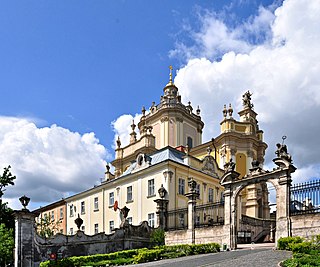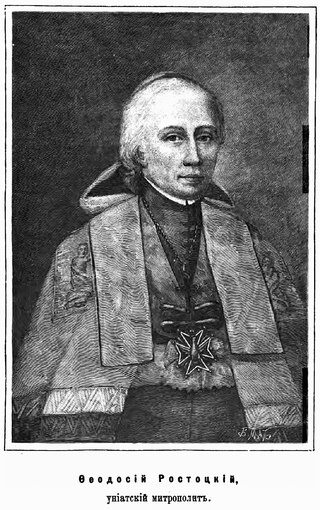
The Ukrainian Greek Catholic Church (UGCC) is a major archiepiscopal sui iuris ("autonomous") Eastern Catholic church that is based in Ukraine. As a particular church of the Catholic Church, it is in full communion with the Holy See. It is the second-largest particular church in the Catholic Church after the Latin Church. The major archbishop presides over the entire Church but is not distinguished with the patriarchal title. The incumbent Major Archbishop is Sviatoslav Shevchuk.

In the Eastern Catholic Churches, major archbishop is a title for the chief hierarch of an autonomous particular Church that has not been "endowed with the patriarchal title". Major archbishops generally have the same rights, privileges, and jurisdiction as Eastern Catholic patriarchs, except where expressly provided otherwise, and rank immediately after them in precedence of honor.

The Catholic Church in Ukraine is part of the worldwide Catholic Church, under the spiritual leadership of the Pope in Rome. Catholics make up 10% of the population of Ukraine.

St. George's Cathedral is a baroque-rococo cathedral located in the city of Lviv, the historic capital of western Ukraine. It was constructed between 1744-1760 on a hill overlooking the city. This is the third manifestation of a church to inhabit the site since the 13th century, and its prominence has repeatedly made it a target for invaders and vandals. The cathedral also holds a predominant position in Ukrainian religious and cultural terms. During the 19th and 20th centuries, the cathedral served as the mother church of the Ukrainian Greek Catholic Church.

Joseph Velamin-Rutski - was the "Metropolitan of Kiev, Galicia and all Ruthenia" in the Ruthenian Uniate Church — a sui juris Eastern Catholic Church in full communion with the Holy See. He reigned from 1613 to 1637. He worked to build the Greek Catholic Church in the first few decades after the Union of Brest of 1596; he also reformed the Basilian monks.
The Major Archeparchy of Kyiv–Galicia (Kyiv–Halych) is an ecclesiastical territory or ecclesiastical province of the Ukrainian Greek Catholic Church — a particular Eastern Catholic Church, that is located in Ukraine. It was erected on 21 August 2005 with the approval of Pope Benedict XVI. There are other territories of the Church that are not located in Ukraine. The cathedral church — the Cathedral of the Resurrection of Christ — is situated in the city of Kyiv. The metropolitan bishop is — ex officio — the Primate of the Ukrainian Greek Catholic Church. The incumbent major archbishop is Sviatoslav Shevchuk.

The Archeparchy of Lviv is an ecclesiastical territory or ecclesiastical province of the Ukrainian Greek Catholic Church — a particular Eastern Catholic Church, that is located in Ukraine. It was erected in 1807. As a metropolitan see, it has three suffragan sees: Stryi, Sambir-Drohobych, and Sokal–Zhovkva. The incumbent Metropolitan Archbishop is Ihor Vozniak. The cathedral church of the archeparchy is St. George's in the city of Lviv.

The Ukrainian Catholic Archeparchy of Kyiv is an ecclesiastical territory or archdiocese (archeparchy) of the Ukrainian Greek Catholic Church, a particular Eastern Catholic Church, that is located in the central part of Ukraine. The ordinary is the Archeparch of Kyiv who is also the Metropolitan of the ecclesiastical province of Kyiv-Halych and the Primate of the Ukrainian Greek Catholic Church. The incumbent Archeparch is Sviatoslav Shevchuk. He is assisted by two auxiliary bishops: Bohdan Dzyurakh and Josyf Milyan. The Archeparchy of Kyiv founded the newspaper "Sobor".

The Ukrainian Catholic Archeparchy of Przemyśl–Warsaw is an ecclesiastical territory or ecclesiastical province of the Ukrainian Greek Catholic Church — a particular Eastern Catholic Church, that is located in the south-eastern part of Poland. It was erected in 1996. Its Byzantine Rite services are conducted in the Ukrainian language. As a metropolitan see, it has two suffragan sees: Olsztyn–Gdańsk and Wrocław-Koszalin. The incumbent ordinary of the archeparchy is Eugeniusz Popowicz. It is assisted and protected by the Dicastery for the Eastern Churches in Rome. The cathedral church of the archeparchy is the Cathedral of St. John the Baptist, in the city of Przemyśl. Although the national capital of Warsaw was added to its title, there is no co-cathedral.
Lev Shlubych Zalenskyj was the "Metropolitan of Kiev, Galicia and all Ruthenia" in the Ruthenian Uniate Church — a sui juris Eastern Catholic Church in full communion with the Holy See. He reigned from 1694 until his death in 1708.

The Ukrainian Greek Catholic Church in the USSR refers to the period in its history between 1939 and 1991, when Ukraine was part of the Soviet Union.
The Archeparchy of Polotsk-Vitebsk was an archeparchy of the Ruthenian Uniate Church that was situated in the Polish–Lithuanian Commonwealth. From 1596 to 1839, it was a suffragan eparchy of the Metropolis of Kiev, Galicia and all Ruthenia. The cathedral church of the archeparchy was Cathedral of Saint Sophia in the city of Polotsk.
The Ruthenian Catholic Archeparchy of Smolensk was an archeparchy of the Metropolis of Kiev, Galicia and all Ruthenia in the Ruthenian Uniate Church from 1625 to 1778. It was situated in the Polish–Lithuanian Commonwealth in what is today the Smolensk Oblast of the Russian Federation. It used the Byzantine Rite in its services. It was also known as the Ruthenian Catholic Archdiocese of Smolensk or Smoleńsk of the Ruthenians.
Ukrainian Catholic Eparchy of Vilnius and its successor Žyrovyci of the Ukrainians were the only eparchy in Lithuania of the Ukrainian Greek Catholic Church, but short-lived (1809-1828-1833).
The Eparchy of Lutsk–Ostroh was an eparchy in the Ruthenian Uniate Church. It was a suffragan eparchy of the Metropolis of Kiev, Galicia and all Ruthenia. It was situated in the Polish–Lithuanian Commonwealth. Today, the territory of the eparchy is located in the north-western part of the modern state of Ukraine; it encompassed the oblasts (provinces) of Volyn Oblast and Rivne Oblast. From 1921 to 1973, the eparchy was a titular see of the Eastern Catholic Church.
The Eparchy of Volodymyr–Brest was an eparchy of the Ruthenian Uniate Church from 1596 until 1795. It was situated in the Polish–Lithuanian Commonwealth between the rivers Bug and Styr on territory that is today located in parts of the modern states of Ukraine and Belarus. The eparchy was a suffragan of the Metropolis of Kiev, Galicia and all Ruthenia.

The Ruthenian Uniate Church was a particular church of the Catholic Church in the territory of the Polish–Lithuanian Commonwealth. It was created in 1595/1596 by those clergy of the Eastern Orthodox Church who subscribed to the Union of Brest. In the process, they switched their allegiances and jurisdiction from the Ecumenical Patriarchate of Constantinople to the Holy See. It had a single metropolitan territory — the Metropolis of Kyiv, Galicia and all Ruthenia. The formation of the church led to a high degree of confrontation among Ruthenians, such as the murder of the hierarch Josaphat Kuntsevych in 1623. Opponents of the union called church members "Uniates" although Catholic documents no longer use the term due to its perceived negative overtones. In 1620, these dissenters erected their own metropolis — the "Metropolis of Kyiv, Galicia and all Ruthenia".

Athanasius Szeptycki was the "Metropolitan of Kiev, Galicia and all Ruthenia"

Theodosius Rostocki was the "Metropolitan of Kiev, Galicia and all Ruthenia". He became the first Uniate bishop who was a member of the Polish Senate.













